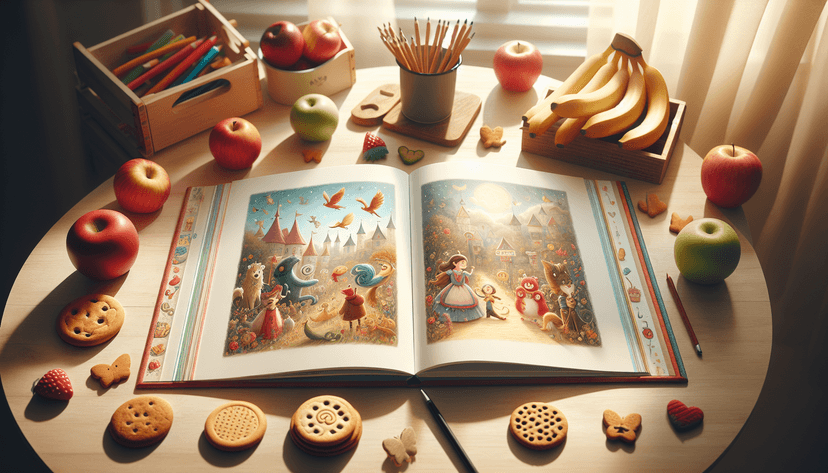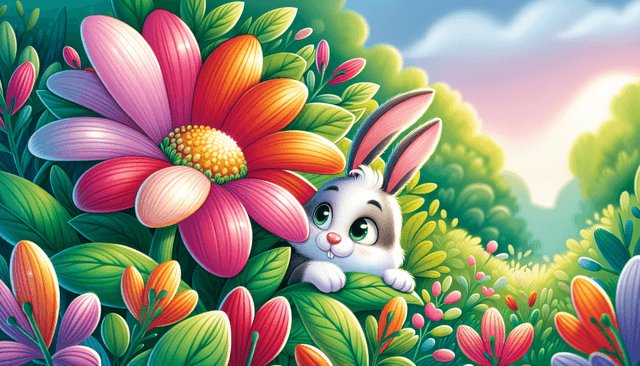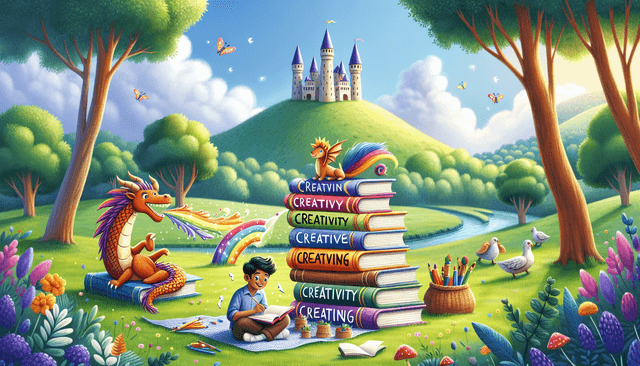Table of Contents
Creating kids’ books can feel overwhelming, right? You might be brimming with ideas but unsure where to start or how to make them truly engaging for young readers. It’s completely normal to hit a roadblock when you’re trying to craft the perfect story for kids!
But here’s the good news: if you stick around, you’ll discover a treasure trove of creative kids’ book ideas that can spark your imagination. We’ll explore fun themes, memorable characters, and unique formats that will not only capture children’s attention but also keep them coming back for more.
From illustration inspiration to tips for navigating publishing, this guide will help you create delightful stories that resonate with young minds. So grab your favorite snack and let’s jump into the colorful world of children’s literature together!
Key Takeaways
- Start with relatable ideas focusing on themes like friendship, adventure, and overcoming fears.
- Mix genres for a fresh twist, such as mysteries in space or everyday superheroes.
- Create diverse and memorable characters, like a shy turtle or a wise owl, to engage kids.
- Choose formats wisely—picture books for younger kids and graphic novels for reluctant readers.
- Use vibrant and interactive illustrations to enhance storytelling and keep kids entertained.
- Address age-appropriate topics, varying themes with the child’s age and interests.
- Incorporate inspiring messages subtly, emphasizing values like kindness and teamwork.
- Include interactive elements like puzzles or coloring pages to boost engagement and creativity.

Creative Kids Book Ideas
Creating a captivating kids’ book starts with a solid idea that resonates with young readers. Think about their interests and experiences, like friendship, adventure, or overcoming fears.
Incorporating themes that promote empathy, curiosity, or problem-solving can also spark interest. Remember, kids love stories that reflect their own lives and challenges.
A fun twist is to combine genres—how about a mystery story set in space or a fantasy tale featuring everyday superheroes? Let your imagination run wild!
Pro tip: Keep a running list of ideas inspired by your daily life or conversations with kids. These snippets can hatch into fantastic stories!
Fun Story Themes for Kids
Story themes play a crucial role in engaging young readers, and there are endless possibilities. Themes like friendship, bravery, and nature teach valuable life lessons.
You might consider adventurous themes like treasure hunts or exploring new worlds. Kids adore the idea of discovery and the thrill that comes with it.
Another great theme is family—stories that highlight the importance of family bonds can be heartwarming and relatable. Mix in fun, quirky characters to keep it lively.
If you’re looking for inspiration, check out writing prompts specially designed for kids, like those found in funny writing prompts for kids. These can help jumpstart your imagination.
Engaging Characters for Children’s Books
Characters are the heart of any good story—especially in children’s books. Think about making your characters relatable and diverse, as this can help every child see themselves in your story.
Kids love characters who face challenges but show resilience. For example, a shy turtle who strives to join a race can teach lessons about bravery and hard work.
Animals are timeless favorites. A wise owl or a mischievous cat can create a fun dynamic, and their personalities can be exaggerated for comedic effect.
Don’t forget to give your characters unique traits or quirks! This will make them memorable. Think of things like a squirrel who loves to read or a dragon that can’t breathe fire.
Different Book Formats for Kids
The format of a children’s book can greatly influence its success. Picture books are fantastic for younger children, as they rely on illustration to tell the story.
Chapter books introduce young readers to longer narratives. They are perfect for early readers transitioning from picture books and typically include illustrations to keep their attention.
If you want to get creative, consider interactive formats like pop-ups or lift-the-flap books. Kids enjoy participation, so engaging their senses can enhance their reading experience.
Graphic novels are gaining popularity too! Combining visuals with text not only captivates kids but can also support reluctant readers by making reading feel less daunting.

Illustration Ideas for Children’s Stories
Illustrations can make or break a children’s book, so it’s essential to think creatively about how to visualize your story.
Consider styles that complement your narrative—whimsical, realistic, or abstract that resonate with kids. For instance, bright colors can attract young readers while softer pastels may suit more tender stories.
Incorporating elements that kids can interact with, like textures or lift-the-flap sections, can elevate the storytelling experience. Illustrations should not only entertain but also help convey the story’s emotions and themes.
Look to real-life cultures for inspiration. Stories featuring diverse settings and characters can teach kids about the world while keeping them engaged.
Don’t forget the power of humor! Silly illustrations can capture attention and elicit giggles, making the reading experience memorable.
How to Choose Age-Appropriate Topics
Picking the right topics for your children’s book means knowing your audience. Start with understanding the age groups and what resonates with them.
For younger kids, simple stories about everyday feelings or family dynamics tend to work best. Asking questions about their experiences can give you plenty of ideas.
As children grow, they begin to seek more complex themes like friendship dilemmas or adventures. You can introduce elements of mystery or magical realism for those early middle-grade readers.
Teen readers, on the other hand, are often exploring identity and independence, so themes of self-discovery or social issues can capture their interest.
It’s helpful to consult resources like age-specific writing prompts to find what younger readers might connect with.
Inspiring Messages and Lessons for Kids
Creating a kids’ book with an inspiring message can leave a lasting impact on young readers. Kids are drawn to stories where characters overcome challenges or grow in meaningful ways.
Messages about kindness, resilience, and teamwork can be woven seamlessly into the plot. For instance, a story about a group of animals working together to overcome obstacles can teach the value of collaboration.
Using relatable characters will help kids understand these lessons better. They should see themselves reflected in the story, making the message feel personal.
Incorporate discussion questions at the end of your book to make it interactive. This can spark conversations between kids and adults about the themes, reinforcing what they’ve learned.
Also, ensure that the lessons are subtle and not preachy. Allow the narrative to convey the message naturally, so it resonates more with young minds.
Interactive Elements to Include in Kids Books
Merging fun with learning is key in children’s literature, and interactive elements can do just that.
Think about adding activities like puzzles, coloring pages, or QR codes that link to audio versions of the story. These can enhance reader engagement.
Lift-the-flap sections create a sense of mystery and surprise. Kids love discovering hidden elements that can lead to new narratives within the book.
Incorporating prompts for kids to write or draw their own endings could add a personal touch that fosters creativity.
Importantly, don’t overwhelm your audience. The interactions should feel natural and enhance the storytelling rather than distract from it.

Tips for Writing and Publishing Kids Books
Writing and publishing a kids’ book can feel overwhelming at first, but with some straightforward tips, you can simplify the process.
First, focus on your writing style; aim for a tone that matches your target age group. The younger the audience, the simpler your language should be.
Next, consider joining a writing community, either locally or online. Surrounding yourself with like-minded writers can provide motivation, feedback, and connections.
Once your manuscript is polished, research publishers who specialize in children’s literature. Tailor your submissions based on their guidelines for a better chance of acceptance.
If you’re feeling entrepreneurial, self-publishing is a viable option. Platforms like Amazon Kindle Direct Publishing make it easier than ever to see your book on virtual shelves.
Don’t skip the illustrations; even if you’re publishing text-only, illustrations can enhance the book’s appeal. Consider teaming up with an illustrator who shares your vision.
Lastly, don’t underestimate marketing. Building a social media presence or starting a blog can help promote your book and connect with your audience before launch.
Popular Genres for Children’s Books
When it comes to children’s books, there are several genres that tend to capture young readers’ hearts.
Adventure stories are perennially popular. Kids love the excitement of journeys—think treasure hunts, magical worlds, or epic quests.
Another beloved genre is fantasy, where imaginations can run wild with dragons, fairies, and talking animals.
Realistic fiction opens a door to relatable experiences, allowing children to see their lives reflected in the stories they read.
Mystery novels also hold a special place in kids’ literature, often featuring clever protagonists who solve puzzles or uncover secrets.
Lastly, humor is universal. Books that make kids laugh not only keep them engaged but also foster a love for reading.
When choosing a genre, think about what excites you as an author and what resonates with your target audience.
Resources for Kid-Friendly Book Ideas
If you’re on the hunt for inspiration, numerous resources can ignite your creativity.
Start by checking out sites like Goodreads to explore popular children’s books and see what themes or styles resonate with young readers.
Library websites often provide lists of award-winning books, which can spark ideas for your own storytelling.
Online writing communities, such as FictionPress, offer a platform to share your drafts, seek feedback, and discover new ideas.
Don’t forget about social media! Follow children’s book authors and illustrators on platforms like Instagram or Twitter to catch inspiration from their posts.
If you’re more hands-on, consider attending local book fairs or children’s literature festivals; interacting with fellow writers can lead to new ideas.
Lastly, always keep a notebook handy for jotting down ideas as they come—sometimes the best ones happen in the most unexpected places!
FAQs
Popular story themes for children include friendship, adventure, overcoming fears, diversity, and imaginative worlds. These themes resonate well with kids and can be adapted to various formats and age groups for greater engagement.
To choose age-appropriate topics, consider the child’s developmental stage, interests, and comprehension level. Research current trends and what captivates different age groups to ensure relevance and appeal in your storytelling.
Interactive elements can include flaps to lift, textures to touch, questions for readers to answer, or activities related to the story. These elements enhance engagement and make reading a more immersive experience for children.
Focus on clear, engaging writing and consider the visual aspects of your book. Explore traditional publishing vs. self-publishing, and seek feedback from children’s librarians or educators to improve your work before publishing.
